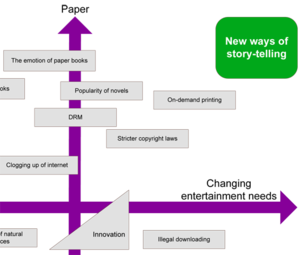Difference between revisions of "New ways of story-telling"
| Line 23: | Line 23: | ||
'''Technological innovation and social factors''' | '''Technological innovation and social factors''' | ||
This scenario is based on technological innovation and social factors. People continue to read because of the experience the books is providing, but the new technologies facilitates the access to books and gives more options to entertainment.The technological innovations ensure that the environment is not harmed in any way as the printing process is environmental-friendly. | This scenario is based on technological innovation and social factors. People continue to read because of the experience the books is providing, but the new technologies facilitates the access to books and gives more options to entertainment.The technological innovations ensure that the environment is not harmed in any way as the printing process is environmental-friendly. | ||
=Conclusion= | =Conclusion= | ||
Books, although slightly changed from their ancient model, still are a very big part of entertainment and are enjoyed by billions of people worldwide.Educational books will continue to be provided on paper. | Books, although slightly changed from their ancient model, still are a very big part of entertainment and are enjoyed by billions of people worldwide.Educational books will continue to be provided on paper. | ||
Revision as of 01:26, 22 May 2009
The scenario
Fast-paced society
Our entertainment needs have drastically changed in the past years. Our society has gone into the highest gear; everything is so fast paced now. Video games are the obvious choice as new prominent form of entertainment, and for a while it even looked like they were going to take over all other forms of entertainment. But this didn't happen. Computer games are usually not something you can just take with you, or pick up anywhere and quickly play in short time spans. Furthermore people sometimes don't want to be bombarded by all the audio-visual force that video-game throw at you. As an alternative to video games people surprisingly kept reading books. Books of paper even! Since people seemingly could not let go of the particular experience a paper book provides.
A new model for book
Because of the change of entertainment needs publishers saw a big drop in book sales at first. But after they came up with a whole new model to provide books sales were skyrocketing again. The publishers and writers understood that their new audience wanted quick bite-sized stories, and even some interactivity in their books. And thus came the new way of storytelling: stories became shorter and episodic content became very popular. Also books in which the reader could have a choice of how the story would roll out became very popular: here a reader would get a few options on how he wanted the characters to react and download part of the story that would allow for that response. The whole model was supported by on-demand printing. People could just download their weekly episode of their favorite book and print it themselves. The printers even received some sort of intelligence and would print the book with a storyline that would most appeal to that user, based on data mining on previous story paths taken.
The role of publishers
The role of the publisher changed somewhat with this new model too. They would now maintain subscription based websites which would have new episodic content to download every day. Furthermore the larger publishers also maintained a vast network of "vending machine like" on-demand book printers. These would use recycled paper and non-oil based ink to print environmental friendly books.
Educational literature
Educational books continue to be distributed on paper because digital readers did not provide the same experience for children while studying.
Background information
Innovation in the story writing
Although some companies might be tempted to scan and make available several books, in this scenario this situation will be quite difficult to achieve in the case of novels. That is because most novels will be constantly developed by the authors. Each book will have a story line, and based on the reader's input, the storyline will be adapted.This means that to actually write a book, authors need to spend a lot of time before having it all available. That's why, they will work on the book daily and make pieces of it available at certain time interval. This is not only an innovative way of writing but also ensures that the illegal distribution of books is more difficult.
On-demand printing and innovation in the distribution channel
Novel books are distributed mostly via internet and printed on demand. This way of distributing books ensures that the environment has less to suffer from the printing industry as on-demand printing is 100% based on recycled paper and the toner is environmental-friendly. Educational books will also be mostly distributed via on-demand printing.
Technological innovation and social factors
This scenario is based on technological innovation and social factors. People continue to read because of the experience the books is providing, but the new technologies facilitates the access to books and gives more options to entertainment.The technological innovations ensure that the environment is not harmed in any way as the printing process is environmental-friendly.
Conclusion
Books, although slightly changed from their ancient model, still are a very big part of entertainment and are enjoyed by billions of people worldwide.Educational books will continue to be provided on paper.
